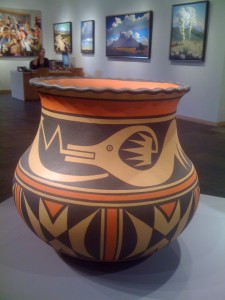I recently returned from our Summer Away program in Santa Fe, New Mexico. While at the Taos Pueblo, I purchased a pot crafted by an Acoma artist at a small shop. As I handed the money to the owner, she commented, “This artist has a patent on this design. No one else can make pots with this design on it.â€Â Wondering to myself if there is something perceptible about me that screams talk-to-me-about-IP, I thanked the woman and left. Here is the pot:

The design depicts a legend that is common to several different tribes, which is the legend of the water serpent. It has various names in different tribes, such as Kolowisi in Zuni, Pachua in Hopi, and Avanyu in tribes of the Rio Grande outlier regions. When I showed the pot to a colleague, she commented that a very similar image was painted on the Zuni mission church. Later that day, we went to an upscale gallery in Santa Fe where I happened to notice this pot:

This might be an interesting exercise for an in-class discussion on what is protectable and what is not protectable cultural expression. Of course, despite the shop owner’s assertions, neither utility nor design patents are apt here. However, there could be source identification of a design with a particular artist. (I did a quick search of the trademark office records online and, with the caveat that design mark records are notoriously difficult to find, didn’t find any marks registered by the artist.)  Perhaps the artist registered a copyright, and believes that affords exclusive protection. In any event, this situation raises questions about the scope of various forms of IP protection, as well as public and private ownership of cultural expressions and heritage, which might be useful in the classroom.